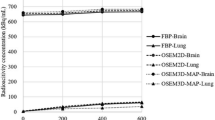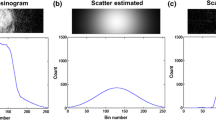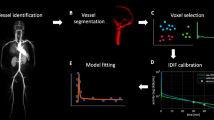Abstract
The purpose of this study was to develop a reliable and practical strategy that generates quantitative CBF and OEF maps accurately from PET data sets obtained with 15O-tracers.
Sequential sinogram data sets were acquired after the administration of 15O-tracers, and combined single-frame images were obtained. The delay time between sampled input function and the brain was estimated from the H2 15O study with the whole brain and the arterial time-activity curves (TACs). The whole-brain TACs were obtained from the reconstructed images (image-base method) and the sinogram data (sinogram-base method). Six methods were also evaluated for the dead-time and decay correction procedures in the process of generating a single-frame image from the dynamic sinogram.
The estimated delay values were similar with both the sinogram-based and image-based methods. A lumped correction factor to a previously added single-frame sinogram caused an underestimation of CBF, OEF and CMRO2 by 16% at maximum as compared with the correction procedure for a short sinogram. This suggested the need for a dynamic acquisition of a sinogram with a short interval. The proposed strategy provided an accurate quantification of CBF and OEF by PET with 15O-tracers.
Similar content being viewed by others
References
Ter-Pogossian MM, Herscovitch P. Radioactive oxygen-15 in the study of cerebral blood flow, blood volume, and oxygen metabolism. Semin Nucl med 1985; 15: 377–394.
Subramanyam R, Alpert NM, Hoop B Jr, Brownell GL, Taveras JM. A model for regional cerebral oxygen distribution during continuous inhalation of 15O2, C15O and C15O2. J Nucl Med 1978; 19: 48–53.
Lammertsma AA, Heather JD, Jones T, Fracowiak RSJ, Lenzi G. A statistical study of the steady state technique for measuring regional cerebral blood flow and oxygen utilization using 15O. J Comput Assist Tomogr 1982; 6: 566–573.
Jones SC, Greenberg JH, Reivich M. Error analysis for the determination of cerebral blood flow with the continuous inhalation of 15O-labeled carbon dioxide and positron emission tomograph. J Comput Assist Tomogr 1982; 6: 116–124.
Correia JA, Alpert NM, Buxton RB, Ackerman RH. Analysis of some errors in the measurement of oxygen extraction and oxygen consumption by the equilibrium inhalation method. J Cereb Blood Flow Metab 1985; 5: 591–599.
Okazawa H, Yamauchi H, Sugimoto K, Takahashi M, Toyoda H, Kishibe Y, et al. Quantitative Comparison of the Bolus and Steady-State Method for Measurement of Cerebral Perfusion and Oxygen Metabolism: Positron Emission Tomography Study Using 15O-Gas and Water. J Cereb Blood Flow Metab 2001; 21: 793–803.
Bigler RE, Sgouros G. Biological analysis and dosimetry for 15O-labeled O2, CO2, and CO gases administered continously by inhalation. J Nucl Med 1983; 24: 431–437.
Raichle ME, Martin WR, Herscovitch P, Mintun MA, Markham J. Brain blood flow measured with intravenous H2 15O. II. Implementation and validation. J Nucl Med 1983; 24: 790–798.
Herscovitch P, Markham J, Raichle ME. Brain blood flow measured with intravenous H2 15O. I. Theory and error analysis. J Nucl Med 1983; 24: 782–789.
Kanno I, Iida H, Miura S, Murakami M, Takahashi K, Sasaki H, et al. A system for cerebral blood flow measurement using an H2 15O autoradiographic method and positron emission tomography. J Cereb Blood Flow Metab 1987; 7: 143–153.
Mintun MA, Raichle ME, Martin WR, Herscovitch P. Brain oxygen utilization measured with O-15 radiotracers and positron emission tomography. J Nucl Med 1984; 25: 177–187.
Ohta S, Meyer E, Thompson CJ, Gjedde A. Oxygen consumption of the living human brain measured after a single inhalation of positron emitting oxygen. J Cereb Blood Flow Metab 1992; 12: 179–192.
Iida H, Higano S, Tomura N, Shishido F, Kanno I, Miura S, et al. Evaluation of regional differences of tracer appearance time in cerebral tissues using [15O] water and dynamic positron emission tomography. J Cereb Blood Flow Metab 1988; 8: 285–288.
Iida H, Kanno I, Miura S, Murakami M, Takahashi K, Uemura K. Error analysis of a quantitative cerebral blood flow measurement using H2(15)O autoradiography and positron emission tomography, with respect to the dispersion of the input function. J Cereb Blood Flow Metab 1986; 6: 536–545.
Dhawan V, Conti J, Mernyk M, Jarden JO, Rottenberg DA. Accuracy of PET RCBF measurements: effect of time shift between blood and brain radioactivity curves. Phys Med Biol 1986; 31: 507–514.
Iida H, Jones T, Miura S. Modeling approach to eliminate the need to separate arterial plasma in oxygen-15 inhalation positron emission tomography. J Nucl Med 1993; 34: 1333–1340.
Kanno I, Iida H, Miura S, Murakami M. Optimal scan time of oxygen-15-labeled water injection method for measurement of cerebral blood flow. J Nucl Med 1991; 32: 1931–1934.
Sadato N, Carson RE, Daube-Witherspoon ME, Campbell G, Hallett M, Herscovitch P. Optimization of noninvasive activation studies with 15O-water and three-dimensional positron emission tomography. J Cereb Blood Flow Metab 1997; 17: 732–739.
Iida H, Kanno I, Miura S. Rapid measurement of cerebral blood flow with positron emission tomography Exploring the brain functional anatomy with positron tomography. In CIBA Foundation Symposium Book 163. John Wiley & Sons, 1991: 23–37 and discussion 37–34.
Iida H, Bloomfield PM, Miura S, Kanno I, Murakami M, Uemura K, et al. Effect of Real-Time Weighted Integration System for Rapid Calculation of Functional Images in Clinical Positron Emission Tomography. IEEE Trans Med Img 1995; 14: 116–121.
Van den Hoff J, Burchert W, Muller-Schauenburg W, Meyer GJ, Hundeshagen H. Accurate Local Blood Flow Measurements with Dynamic PET: Fast Determination of Input Function Delay and Dispersion by Mutilinear Minimization. J Nucl Med 1993; 34: 1770–1777.
Iida H, Kanno I, Miura S, Murakami M, Takahashi K, Uemura K. A determination of the regional brain/blood partition coefficient of water using dynamic positron emission tomography. J Cereb Blood Flow Metab 1989; 9: 874–885.
Weinhard K, Dalbom M, Eriksson L, Michel CH, Pietrzyk U, Heiss WD. Comparative performance evaluation of the ECATEXACT and ECATEXACT HR positron camera. In Quantification of Brain Function. Tracer Kinetics and Image Analysis in Brain PET, Uemura K (ed.), Amsterdam; Elsevier Science Publishers, 1993; 363–367.
Shao L, Karp JS. Cross-plane scattering correction-point source deconvolution in PET. IEEE Trans Med Img 1991; 10: 234–239.
Iida H, Law I, Pakkenberg B, Krarup-Hansen A, Eberl S, et al. Quantitation of regional cerebral blood flow corrected for partial volume effect using O-15 water and PET: I. Theory, error analysis, and sterologic comparison. J Cereb Blood Flow Metab 2000; 20: 1237–1251.
Law I, Iida H, Holm S, Nour S, Rostrup E, Svarer C, et al. Quantitation of regional cerebral blood flow corrected for partial volume effect using O-15 water and PET: II. Normal values and gray matter blood flow response to visual activation. J Cereb Blood Flow Metab 2000; 20: 1252–1263.
Mazoyer BM, Roos MS, Huesman RH. Dead-time correction and counting statistics for positron tomography. Phys Med Biol 1985; 30: 385–399.
Meyer E. Simultaneous correction for tracer arrival delay and dispersion in CBF measurements by the H2 15O autoradiographic method and dynamic PET. J Nucl Med 1989; 30: 1069–1078.
Author information
Authors and Affiliations
Corresponding author
Rights and permissions
About this article
Cite this article
Shidahara, M., Watabe, H., Kim, K.M. et al. Evaluation of a commercial PET tomograph-based system for the quantitative assessment of rCBF, rOEF and rCMRO2 by using sequential administration of 15O-labeled compounds. Ann Nucl Med 16, 317–327 (2002). https://doi.org/10.1007/BF02988616
Received:
Accepted:
Issue Date:
DOI: https://doi.org/10.1007/BF02988616




